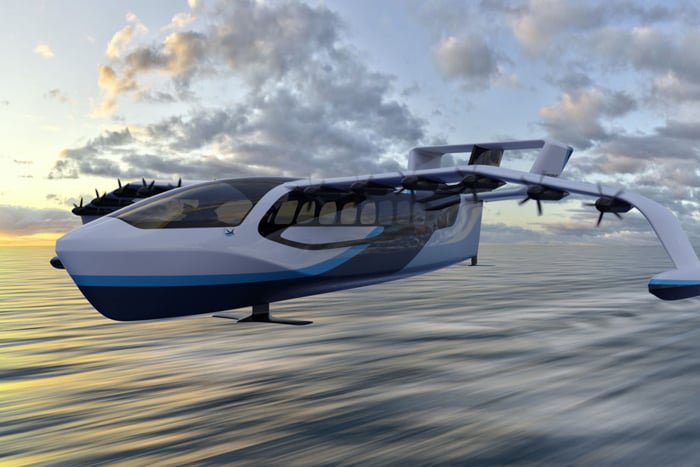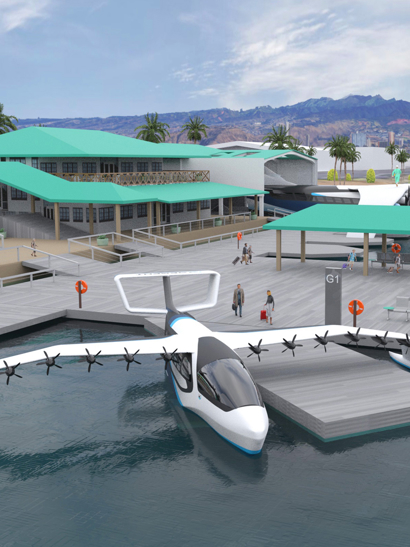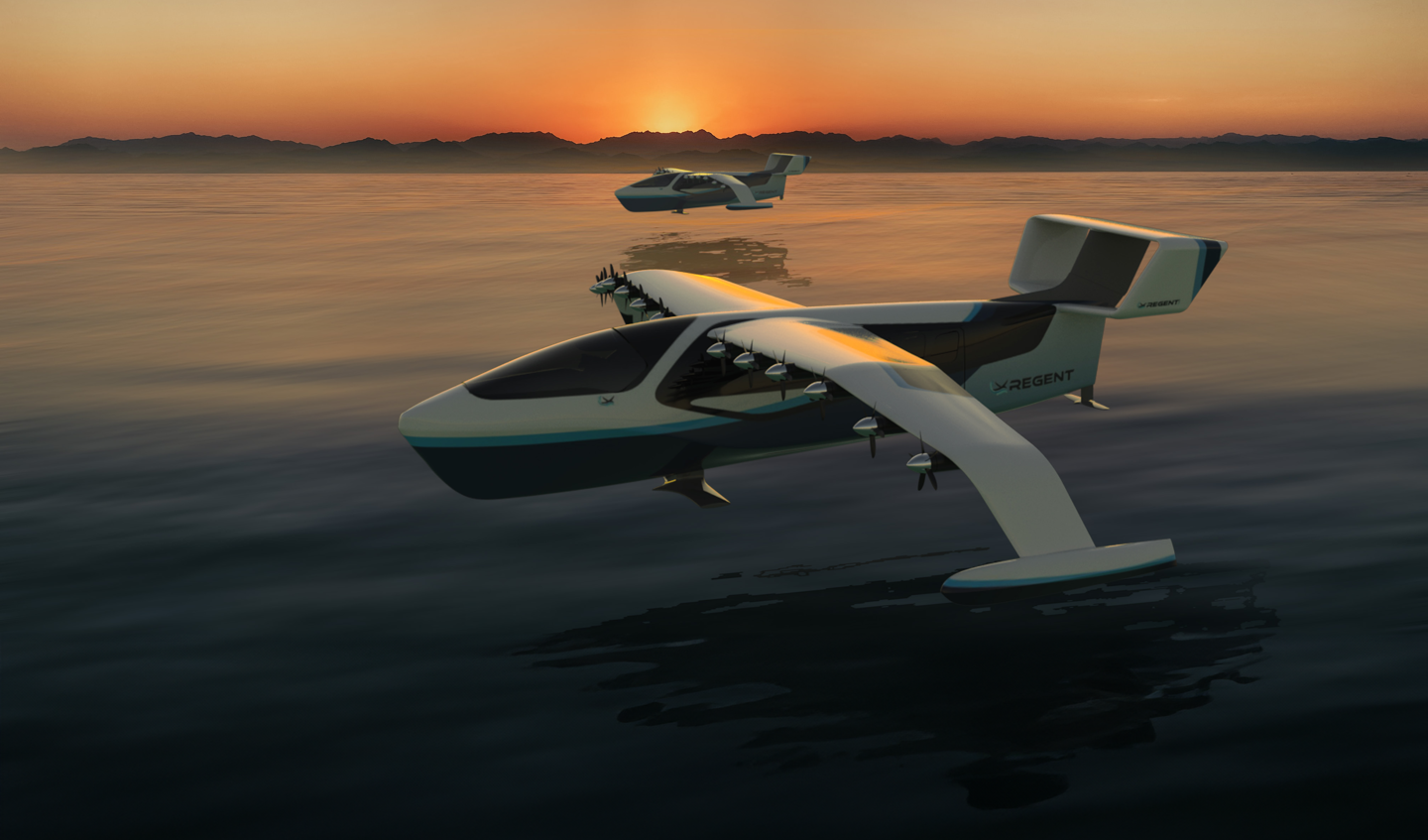A new mode of all-electric high-speed maritime transport, the ‘seaglider’, under development by Rhode Island-based REGENT Craft Inc, could reshape passenger and logistics transport across the globe within this decade.
The hydrofoiling wing-in-ground (WIG) seaglider technology will provide a completely new mode of transport that combines ‘float, foil, fly’ operations in one vehicle. The zero-emission transport mode has already attracted the attention of airlines, ferry companies, municipal authorities, logistics firms, defence corporations and a broad range of investors.
By the end of this decade, seagliders are expected to have scaled up so that 100 passengers will be able to travel on board seagliders at speeds of up to 180 miles per hour. Harnessing the ‘ground effect’ – which reduces aerodynamic drag generated by a winged craft close to a fixed surface – seagliders will be able to travel at high speeds just 5-10 metres above the water.
The technology is already attracting wide attention. In fact, REGENT chief executive and co-founder, Billy Thalheimer, reveals that the company now has a 600-unit orderbook worth over $9 billion.
A multitude of applications
Seaglider systems are relevant for many sectors. Although fast passenger transport is the main focus for the moment, the technology is already proving attractive to logistics firms and offshore operators. Late in 2022, for example, REGENT signed a strategic partnership deal with energy major, TotalEnergies, to explore the use of seagliders for the transport of personnel to and from offshore wind farms and oil platforms.
A quarter-scale seaglider prototype has successfully completed more than 12 months of testing, and REGENT will soon begin sea trials of the full-scale prototype, Thalheimer says. The company is now planning to have a 20-metre wingspan 12-passenger ‘Viceroy’ seaglider in operation ‘by mid-decade’.
With a 6,800 kilogram payload, it will be operated by specially trained maritime personnel. By the end of the decade, 100-passenger ‘Monarch’ seagliders are likely to be in operation in key coastal markets around the globe, he declares.
Since its inception, REGENT, an acronym for Regional Electric Ground Effect Nautical Transport, has attracted a wide range of investors and future clients. Capital providers, led by 8090 Industries and Founders Fund, include Japan Airlines, Mesa Air Group, Lockheed Martin, Yamato Holdings, Thiel Capital, JAM Fund, Mark Cuban, Y Combinator, Caffeinated Capital, and Fitbit founder, James Park. Early in May, REGENT announced a $300m deal with asset leasing company, Monte Maritime.


Complex certification process
The scale of global interest is one of the reasons that REGENT has chosen LR as its assurance partner. The company wants to have a globally recognised classification body that can liaise with regional authorities as necessary.
Ted Lester, the company’s Vice President, Certification, tells Horizons that REGENT will pursue two certification processes running in parallel. In the US, for example, one of these will be carried out with the US Coast Guard relating to seaglider projects and deployments in US waters.
Simultaneously, assurance from LR will apply to projects around the world where the classification society will work with local regulatory bodies such as the Federal Maritime Authority in the United Arab Emirates, for example.
“One of the most exciting aspects of starting this work with Lloyd’s Register is that we have an international capability in having Lloyd’s class that we can take to our customers all around the world,” Lester explains.
Although seagliders operate within one wing span of the water in their ‘fly’ mode, they use hydrofoils for manoeuvring in busy waters. Under International Maritime Organization regulations, they are therefore classed as a WIG ‘Type A’ craft meaning that they cannot exceed a flight altitude over the maximum vertical extent of ‘ground effect’. For this reason, seagliders will be subject to maritime regulations and operated by specially trained mariners, not pilots.
Rapidly expanding orderbook
Potential customers have also signalled their interest by placing deposits for future orders. Ferry companies have clearly seen the potential for the new form of transport – zero-emission seagliders are half the cost of aeroplanes and at least six times faster than ferries. Brittany Ferries would like to deploy them on the English Channel and Germany’s FRS, which operates passenger and freight services between Sassnitz in northern Germany and Trelleborg in Sweden, is also interested.
Meanwhile, in the US, Thalheimer reveals that various companies in Miami – ‘America’s gateway to the Caribbean’ as he calls it – and operators that are part of the Hawaii Seaglider Initiative (HSI) are planning commercial operations based on the technology. At the launch of the HSI early this year, more than a dozen companies and organisations signed up for membership. They included airlines, construction firms, agricultural enterprises, tourist and travel companies, hotels, retailers and adventure holiday firms.
Thalheimer is keen to stress the global attraction of fast seaglider technology. It has, for example, already caught the attention of investors and transport authorities in the Middle East, Asia, and New Zealand.
In the Middle East, investors and transport operators that have already shown interest include the Abu Dhabi Strategic Development Fund, the Abu Dhabi Investment Office, the Emirate’s Department of Municipalities and Transportation, and Saudi Arabia’s NEOM Investment Fund. Regional transport authorities are considering their deployment both in the waters of the Arabian Gulf and, in due time, the Red Sea.
Meanwhile, New Zealand sustainable transport pioneer, Ocean Flyer, has signed a deal with Monte Maritime to finance the first NZ $145 million ($88.5 million) of the company’s total NZ$ 700 million ($427 million) deal, signed in 2022, for 15 Viceroys and ten Monarchs.
As US Senior Business Development Manager, Graeme Hyde is LR’s man on the spot. Commenting on the tie-up with REGENT, he highlights the multidisciplinary capability of the development team.
“The expertise across the REGENT team is most impressive,” he states. “I was involved in detailed risk assessments recently and I noted the company’s wide expertise in a range of disciplines – not just aviation and maritime but also people who’ve been involved in the Americas Cup who understand hydrofoil technology better than anyone.
“Lloyd’s Register has the longest history of ensuring that vessels are safe and fit for purpose. We will use the same due diligence in cooperating with REGENT to ensure that their fascinating technology is completely safe, that all of the risks are properly understood and mitigated, and that the assets are completely ready for deployment.”







